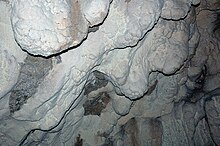Moonmilk

Moonmilk (sometimes called mondmilch, German for moonmilk, sometimes wrongly montmilch, or also cave milk) is a white, creamy substance found inside caves. It is similar to other deposits, but its unique quality is that it does not harden or turn to stone. It is a precipitate from limestone comprising aggregates of fine crystals of varying composition usually made of carbonate materials, e.g., calcite, hydromagnesite, and monohydrocalcite.
Hypotheses about the origin of moonmilk are mixed. Some scientists think it is a bacterial action rather than a chemical one. In this hypothesis, it is thought to be created by the bacterium Macromonas bipunctata. Certain bacterial actions are known to be capable of breaking down stone to form this semiliquid "milk". However, no microbiological studies have been carried out so far.
It was originally thought (by Conrad Gesner, 1555) to be created by "moon rays."
It is possible that moonmilk is formed by extruding water percolations that dissolve and soften the carbonate walls of karstic caves and carry dissolved nutrients that can be used by epilithic microbes, such as actinomycetes. As the microbial colonies grow, they trap and accumulate chemically-precipitated crystals in the organic matter-rich matrix formed that way. Perhaps these heterotrophic microbes, which produce CO2 as a waste product of respiration and maybe organic acids, help to dissolve the carbonate as well. Of course, more research is needed to prove any current hypothesis.
The discovery of a 150 meter long moonmilk river was first announced on March 2004 by a team of speleologists in a cavern in Hernio mountain, in the Basque Country of Guipúzcoa province, Spain. Its exact location is kept secret so as to avoid vandalism.[1] This river is formed by a thick milk-like fluid composed by calcite, quartz and brushite.
Moonmilk was used as a remedy, notably by Gesner in the middle of 16th century, up until the 19th century. It cured acalcinosis and probably cardialgia by neutralicing the acid. It had no adverse health effects, except that the mining cave was somehow damaged.[2]
References
- ^ Hernio, Valle del Oria, Montaña Vasca.
- ^ Moonmilk in showcaves.com.
- George W. Moore and Nicholas Sullivan. Speleology: Caves and the Cave Environment, rev. 3rd ed. Dayton, Ohio: Cave Books, 1997. ISBN 0-939748-46-0 (hardcover), ISBN 0-939748-45-2 (paperback)
External links
- Moonmilk and Cave-dwelling Microbes
- Micromonas bipunctata
- The Virtual Cave: Moonmilk
- Novedades Rio Subterráneo de Leche de Luna (Spanish)
